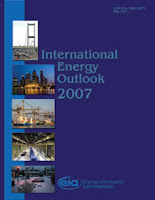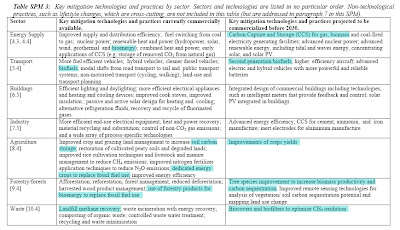 Business Energy Reports publishes a prolific number of excellent research reports that address the "global energy industry" and are available online for purchase. Did I mention that they are pricey? Well they are and it would serve them well to offer a discount based on volume purchases. Still, if you are curious to see one, they do offer a free loss leader called "Market Survey of the Energy Industry" which you receive online if you sign up for their email announcements of new releases.
Business Energy Reports publishes a prolific number of excellent research reports that address the "global energy industry" and are available online for purchase. Did I mention that they are pricey? Well they are and it would serve them well to offer a discount based on volume purchases. Still, if you are curious to see one, they do offer a free loss leader called "Market Survey of the Energy Industry" which you receive online if you sign up for their email announcements of new releases.
 Occasionally they distribute press releases that announce new reports from other agencies that are available online. This week they featured the U.S. Department of Energy's latest International Energy Outlook 2007 which is published through the Energy Information Administration (EIA) website (see below).
Occasionally they distribute press releases that announce new reports from other agencies that are available online. This week they featured the U.S. Department of Energy's latest International Energy Outlook 2007 which is published through the Energy Information Administration (EIA) website (see below).
----------------------------
P R E S S R E L E A S E
For Immediate Release
Press Contact: Barbara Drazga
Press@EnergyBusinessReports.com
Tel: 800-304-0345
www.energybusinessreports.com
 World Energy Use Projected to Grow 57 Percent between 2004 and 2030
World Energy Use Projected to Grow 57 Percent between 2004 and 2030
Phoenix, AZ –May 21, 2007 – World marketed energy consumption is projected to grow by 57 percent between 2004 and 2030, according to the reference case projection from the International Energy Outlook 2007 (IEO2007) released today by the Energy Information Administration (EIA). The IEO2007 shows the most rapid growth in energy demand for nations outside the Organization for Economic Cooperation and Development (OECD) especially in non-OECD Asia, where strong projected economic growth drives the increase in energy use.
Global energy demand grows despite the relatively high world oil and natural gas prices in the reference case. However, rising oil prices dampen growth in demand for petroleum and other liquids fuels after 2015 and, as a result, reducing their share of overall energy use from 38 percent in 2004 to a projected 34 percent in 2030. In contrast, the energy shares of natural gas, coal, and renewable energy sources are expected to grow over this period. Liquids consumption is still expected to grow strongly, however, reaching 118 million barrels per day in 2030. The United States, China, and India together account for nearly half of the projected growth in world liquids use.
To meet the increment in world liquids demand in the IEO2007 reference case, supply in 2030 is projected to be 35 million barrels oil equivalent per day higher than the 2004 level of 83 million barrels per day. Conventional resources account for about 27 million barrels per day of this increase, with a projected 21 million barrels per day increase in production by members of the Organization of Petroleum Exporting Countries (OPEC) and a 6 million barrels per day increase in non-OPEC countries. Production from unconventional resources (including biofuels, coal-to-liquids, and gas-to-liquids) increases by nearly 8 million barrels per day and accounts for 9 percent of total world liquids supply in 2030.
View Details on Related Reports:
Unconventional Gas Outlook: Resources, Economics, and Technologies 2007
Biomass to Biofuels Market Potential 2007
Commercialization of Coal to Liquids Technology 2007
Gas to Liquids Technology and Market Potential
Other EIA report highlights include:
* Coal consumption, which grows an average annual rate of 2.2 percent, is the fastest-growing energy source worldwide in the IEO2007 reference case projection, which assumes that existing laws and policies remain in effect through 2030 notwithstanding concerns related to the rising level of energy-related greenhouse gas emissions. World coal consumption increased sharply from 2003 to 2004, largely because of a 17-percent increase-on a British thermal unit (Btu) basis-in non-OECD Asia (mainly China and India). With oil and natural gas prices expected to continue rising, coal is an attractive fuel for nations with access to ample coal resources, especially in coal-rich countries like China, India, and the United States. These three countries combined account for 86 percent of the increment in world coal demand by 2030 in the reference case projection.
* Higher fossil fuel prices, energy security concerns, improved reactor designs, and environmental considerations are expected to improve prospects for nuclear power capacity in many parts of the world, and a number of countries are expected to build new nuclear power plants. World nuclear capacity is projected to rise from 368 gigawatts in 2004 to 481 gigawatts in 2030. Declines in nuclear capacity are projected only in OECD Europe, where several countries (including Germany and Belgium) have either plans or mandates to phase out nuclear power, and where some old reactors are expected to be retired and not replaced.
* In the IEO2007 reference case, which does not include specific policies to limit greenhouse gas emissions, energy-related carbon dioxide emissions are projected to rise from 26.9 billion metric tons in 2004 to 33.9 billion metric tons in 2015 and 42.9 billion metric tons in 2030. From 2003 to 2004, carbon dioxide emissions from the non-OECD countries grew by almost 10 percent, while emissions in the OECD countries grew by less than 2 percent. The result of the large increase in non-OECD emissions was that 2004 marked the first time in history that emissions from the non-OECD exceeded those from the OECD countries. Further, because of the expectation that non-OECD countries will rely on fossil fuels to supply much of their future energy demand growth, carbon dioxide emissions from the non-OECD countries in 2030 are projected to exceed those from the OECD by 57 percent.
technorati BIOconversion, bioenergy, biofuels, ethanol, decentralization, security
 In marked contrast to the oil crisis of the 70's when cars lined up on even or odd license number days to tank up on gasoline and speed limits were held to 55 MPH to conserve energy, there has been little preaching by this administration - or the states for that matter - to slow down and use less. Memorial Day weekend driving plans were little impacted by recent gas price spikes. Auto shows still promote performance over gas use efficiency.
In marked contrast to the oil crisis of the 70's when cars lined up on even or odd license number days to tank up on gasoline and speed limits were held to 55 MPH to conserve energy, there has been little preaching by this administration - or the states for that matter - to slow down and use less. Memorial Day weekend driving plans were little impacted by recent gas price spikes. Auto shows still promote performance over gas use efficiency.












